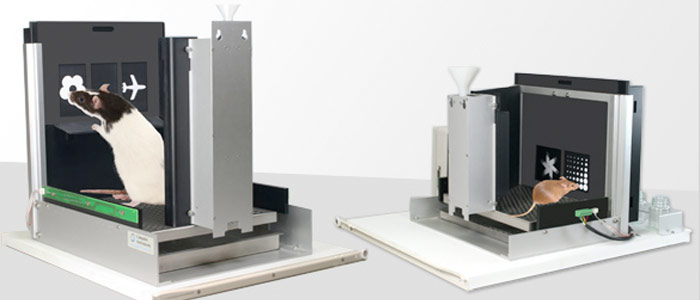Custom touchscreen behavior systems for rodents

Lisa Saksida and Tim Bussey turned touchscreen systems into high throughput tools for rodent behavior assays. When I visited their lab in Cambridge (they’re now based at U Western Ontario in London, Canada, between Detroit, MI and Buffalo, NY), they generously shared some of the critical design aspects to the devices.
My own lab has been using their touchscreen devices for some of our experiments (Stirman, Townsend, and Smith 2016; Yu, Hira, et al. 2018; project blog). We find these tools to be quite effective for exploring aspects of mouse visual perception capabilities (for stimuli displayed on an LCD monitor).
We had to customize the devices a bit, as detailed in the 2016 paper. This included writing our own software from scratch (J. Stirman’s work), and changing to a liquid reward delivery system. However, we kept the chamber design (trapezoidal, easy to clean, durable), and the stock touchscreen, which uses infrared sensors, not capacitive or resistive. This is critical, Lisa and Tim told me, as the system can detect even very light touches. Other technology can require the animals to apply more force. This can be harder for mice than rats, and both species can take longer to learn the system.
There have been a series of DIY touchscreen behavior boxes reported (O’Leary et al. 2018, pictured below; Pineno 2014; Leising et al. 2013). While they all offer lower cost options, and there are interesting aspects to the projects, none appear to be very refined. O’Leary et al. confirmed that rats took over twice as long to learn in the custom system compared to rats trained in a commercial rodent touchscreen system. It is easy to underestimate the amount of R&D and refinement that goes into these systems. We opted to adapt a proven system, rather than start from scratch. That was probably an important project decision.
So while Labrigger generally supports DIY approaches, these included, we just want to caution people against underestimating the thought and expertise that went into the design choices for well-optimized systems. Sometimes modification of commercial products is an easier and overall cheaper solution (if you include the time and money of re-optimization and/or troubleshooting). In our case, Campden was pretty flexible about us ordering just the parts we wanted. That saved us some money, plus we didn’t have to re-engineer a chamber design or a source an infrared touchscreen that would work well with rodents.

